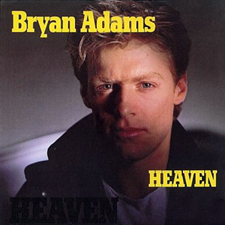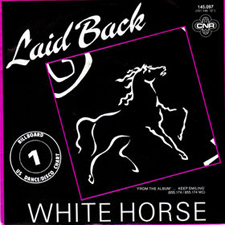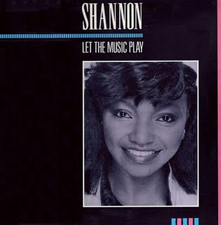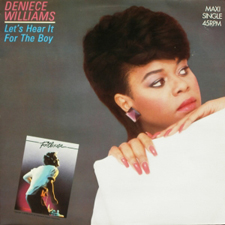Rounding the horn into the back half of Disc Five of this 7-disc set, things get (mildly) funky, we talk a little about race, and Jack makes a dick joke. So, you know. The usual.
#11 Bryan Adams, ”Heaven” (1983)
Recorded for the soundtrack to a little-remembered 1983 film, this hit the Number One spot in June 1985, over a year and a half after its initial release.
Feerick — I give Bryan Adams tremendous props for remaining a public figure for 30+ years while giving virtually nothing away about his personal life. That in itself is a pretty remarkable achievement.
 Certainly moreso than his terrible music, which is meat-and-potatoes rock with a fatally-skewed ratio of potatoes to meat. It fills your ears up, but does not nourish them. A jillion hit singles, and only one of them has any substance — and it ain’t this one. (”Run To You,” if you were wondering.)
Certainly moreso than his terrible music, which is meat-and-potatoes rock with a fatally-skewed ratio of potatoes to meat. It fills your ears up, but does not nourish them. A jillion hit singles, and only one of them has any substance — and it ain’t this one. (”Run To You,” if you were wondering.)
Medsker — I get its appeal, but it never appealed to me. My brother loved turning it into something Gilbert O’Sullivan would appreciate by singing, “I find it hard to believe you’re eleven.”
Cummings — For 20 years I allowed “Heaven” to float around in my head as not-bad-for-a-Bryan-Adams-song … certainly not as soul-draining as “Summer of ’69,” or “Somebody,” or anything he recorded during the ’90s. But I gotta admit, when that electronica version by DJ Sammy hit in ’02, I changed my opinion about the song entirely. Sped-up version, slowed-down version, didn’t matter — I loved that thing, because it epitomizes the emotive-girl-on-top-of-robotic-synths thing that always gets me. Maybe it also reminded me of Cathy Dennis, for whom I was a complete sucker.
Anyway, I hate Bryan Adams as much as everybody else hates Bryan Adams, but as drippy and annoying as his original is, it gets a pass from me.
Lifton — It shocked me to learn that Adams co-wrote all of his songs with Jim Vallance. After all, how does is take two people to collaborate on something as banal as this?
#12 Laid Back, ”White Horse” (1983)
Hit the top spot on the dance charts; #26 in the Top 100.
https://www.youtube.com/watch?v=I8j2ej5jqQw
Medsker — I was all about the beat (and still am) when this came out, but I never got into this song. When I heard the Normal’s “Warm Leatherette” for the first time a few years later, I suddenly understood the minimalistic appeal of this song… but that didn’t make me like it any more. Maybe it’s the woman doing that weird thing with her eyes. That, and the fact that there is not much to sink my teeth into. It just feels unfinished.
 Cummings — If this is about the minimalism, give me “Da Da Da” instead. If this is about the drugs, it’s as insipid as the whole “Just Say No” thing – and in a world where “White Lines” exists, there’s no reason to give “White Horse” the slightest thought. In fact, whatever this is about, don’t make me listen to this again. It’s one of my very least favorite “songs” of the ’80s, or any other era.
Cummings — If this is about the minimalism, give me “Da Da Da” instead. If this is about the drugs, it’s as insipid as the whole “Just Say No” thing – and in a world where “White Lines” exists, there’s no reason to give “White Horse” the slightest thought. In fact, whatever this is about, don’t make me listen to this again. It’s one of my very least favorite “songs” of the ’80s, or any other era.
Feerick — A single-hitter, transparently by design. This was not a group built for the long haul; you do not give your band a feeble, dashed-off name like ”Laid Back” if you ever anticipate having a second hit.
As for the music: A flatulent man with a slide-whistle tells you, ”Don’t do drugs, mmmkay?” Which doesn’t sound like much fun, but in practice, it’s a hoot. The relative lack of ambition is part of what makes it so entertaining; unburdened by any concern for their legacy, Laid Back are free to simply bring the bang. My pick for the week.
Lifton — This isn’t too different from today’s EDM, is it? It’s crude by comparison but the idea is the same, as far as I can tell. I don’t like this, either.
Feerick — Hold that thought, Dave. I want to get back to that after we listen to the next track…
#13 Shannon, ”Let the Music Play” (1983)
Peaked at #4 on the pop chart and topped the dance charts. Shannon’s only Top 40 hit.
Feerick — There’s a thing going on here that I dig — a dense mix of clattering machines with live percussions. It’s an effect I’ve always liked, from back in the day right up to current acts like Simian Mobile Disco and LindstrÁ¸m.
Medsker — Oh, hell yes. I still crank this song whenever I’m lucky enough to hear it on the radio. Great drum track, great percussion, great syncopated rhythms in the keyboard tracks…love, love, love this.
In fact, for anyone who’s a fan of “Let the Music Play,” this 1992 remix by Omar Santana is a must-hear. Dude is my idol.
Cummings — I’ll be the resident contrarian on this one. I can’t stand “Let the Music Play,” and never could. There’s something about it that I find intolerable. It can’t be the concept of a love triangle playing out on a dancefloor – that actually makes sense to me. Is it the sheer vapidity of lyrics like “What does love want me to do”? Is it the utter lack of human emotion in the vocal? Is it the monkeys-with-synthesizers disco arrangement? It’s like Madonna, Shalamar and the Jets — three things I actually like a lot, generally speaking — got thrown into a blender and whipped into a disgusting … yet utterly bloodless … sludge.
Lifton — It goes against a lot of my nature but I’ve always kind of dug this. A good dance-floor filler of the time.
Feerick — And that brings me to a couple of meta-questions, here:
Firstly: Am I the only one in this crew with any love for contemporary EDM? Not just Lifton’s little aside, there, but even back when we were doing our end-of-the-decade poll, I was surprised by how little love there was for, say, LCD Soundsystem — when it seems to me that James Murphy is synthesizing a lot of influences, both classic-rock and underground, that are congenial to the likes of us, and doing it in a way that’s both entertaining and — occasionally — emotionally. Certainly moreso than a lot of the tuneless, precious indie-rock I’m hearing. There are better tunes in any random track by Daft Punk than in an entire album by, say, Bon Iver.
Medsker — I love modern-day EDM, but I think LCD Soundsystem might be the most overrated band of all time. I could never shake the feeling that people liked them solely because it was cool to like them.
Lifton — I think Murphy’s talented, but I wish he would use his skills for something other than ironic updates of classic rock. “Drunk Girls” is fun but it always makes me go right back to “White Light/White Heat.”
Feerick — Okay, table that for now. But let me get to my second point — which may or may not be related: After a long lily-white stretch — in eighteen weeks and 90+ songs, we’ve only covered six artists of color — we’re entering into a comparatively chocolatey patch in the Like, Omigod! set over the next couple of weeks. Now, we’ve already talked a little about the relative lack of hip-hop in this box, coupled with the lack (for reasons of rights clearance) of Michael Jackson and Prince.
I just want to throw the question open, though: Overall, do you think this set is skewing disproportionately white? Or does this jibe with what you were hearing on pop radio, back in the day?
I’ve got my own thoughts on this, but I’m interested in the experience of others…
Cummings — Well, this week’s toooons plunk us down in late ’83 / early ’84, which is instructive because it’s the moment when the floodgates re-opened for black artists on pop radio (and MTV) in the wake of Thriller. I don’t have any stats on the proportion of African-Americans on the pop charts between the “death of disco” (let’s place it in late-summer ’79, when the records blew up at Comiskey and “My Sharona” happened) and Thriller — but it certainly felt like there were fewer than there had been through the ’70s. It’s interesting that you bring this up in the context of “Let the Music Play,” which is a disco song about an event in a disco — it already felt like a throwback when it came out, though it has an updated, ’80s-ish brightness in the synth arrangement.
I’ve mentioned a couple times around these parts that 20 years ago I got away with writing a master’s thesis on African-American music videos and the “crossover dream” – and I revisited that work during our bizarre Al Jarreau theme week a few years back. Anyway, it makes sense to me that the Omigod! box should amp up the presence of black artists at this point in the proceedings. We’ll see how things progress from here, shall we not?
#14 Deniece Williams, ”Let’s Hear It For the Boy” (1984)
From the Footloose soundtrack. A #1 hit on the pop, dance and R&B charts; nominated for an Oscar.
Feerick — I always had time for this song. Tuesday afternoons, to be exact, between 2:30 and 2:35, when I would break from my usual musical diet of nothing but Balinese gamelan, free jazz, and Joy Division bootlegs; put on the Footloose soundtrack; and dance around in my underwear. (Or not.)
This is a cute song. It’s not sexy, by any means — while the lyric carries the clear subtext that while this dumb slob really is no good at anything, and that she keeps him around only because he’s hung like a stallion, it’s operating in a mode of pop that predates sexiness as we think of it today. It’s more akin to Tin Pan Alley. A song like ”Cheek To Cheek“ or ”That Old Black Magic“ might be all about erotic fascination, but it’s not gonna give anyone a boner; the sentiment can plausibly be passed off as puppy love, and the effect of the music is a sexlessly wholesome bounce.
”Let’s Hear It For the Boy” has a little of that Great American Songbook vibe in its tune, as well; mostly it’s down to the sophistication of the changes on the turnaround leading into the chorus. It manages a tricky modulation without the dreaded David Foster CLANG!
Lifton — It’s the Smokey Robinson method – start with an idea and then write the reverse, and give an upbeat chorus. I could do without “Maybe he’s no Romeo / But he’s my lovin’ one-man show,” but this is another example of how the principles of Motown were still being used 20 years later to produce great, if lightweight, pop songs.
 Cummings — I can’t hate it. It’s too cute. It’s too sweet. I think of it the same way I think of that Shanice song from the ’90s, “I Love Your Smile.” Besides, Christopher Penn is dead! How can anybody rip on the song that plays while he learns to dance like a meatball?
Cummings — I can’t hate it. It’s too cute. It’s too sweet. I think of it the same way I think of that Shanice song from the ’90s, “I Love Your Smile.” Besides, Christopher Penn is dead! How can anybody rip on the song that plays while he learns to dance like a meatball?
Medsker — I had no use for this song at the time, but it’s worn me down since. I still don’t think it’s great, and her vocal histrionics at the end are arguably what gave birth to Mariah Carey, and obviously that’s a bad thing. Still, it bothers me less than it used to. Is it possible to be nostalgic for things you never cared about in the first place?
Cummings — Thinking more about African-American representation on this box set: ”Let’s Hear It for the Boy” is much more representative than ”Let the Music Play” of what brought African-American artists back into the pop mainstream. It’s pure crossover in its intention and its execution, and made its mark on the soundtrack to a film without a major black character. It’s too easy (and too reductive) to lump every black artist who succeeded on pop radio in the ’80s as a “crossover act,” but there did often seem to be elements both aural and visual (in the era’s music videos) with which pop listeners were presented as cues that a particular black should be accepted: the inclusion of a song in a white-oriented film like Footloose, a nostalgic bent to the songwriting (see “Cool It Now” below), the use of instrumentation not much different from what Duran Duran was using at the time, or my personal favorite — the immersion of an artist in large, multi-racial crowds in a music video (see “Beat It,” or “All Night Long,” Lionel Richie’s first MTV clip).
Feerick — What’s funny, though — and what sort of led me down this rabbit-hole in the first place — is that crossover also worked the other way. I spent the summer of 1984 working in a warehouse in the city, and the music playing from the office manager’s desk was my first real exposure to ”urban radio” as a broadcasting category. This was Boston’s WILD, then a low-powered dawn-to-dusk station. And what struck me was that the way to distinguish between what I was hearing on WILD vs. what was being played on the rock radio station in the loading dock next door was that the commercials were different. Michael and Prince and Rick James were all over white radio — but at the same time, Hall & Oates and Madonna and David Bowie were all over black radio.
And I don’t remember people thinking or talking in terms of ”crossover” or ”tokenism.” This was just the way things were. This was the future. It seemed like the beginnings of a pop music landscape that was post-racial; it was almost within our grasp.
And then, somehow, we blew it. In the back half of the 80s, white music got whiter, losing its soul inflections in the ascent of hair metal and country. Radio station formats grew polarized. There was no conscious purging of black artists from white radio, or vice versa — just a cultural shift. Bonnie Raitt made her return, and Anita Baker was no longer getting played on white pop radio; she was no longer necessary to White America. Black critics started to wonder aloud if Prince and Michael Jackson were still ”relevant,” because of their ”failure” to properly ”embrace” hip-hop. (Wondering! if Prince! was still fucking relevant!) And Prince withdrew, and Michael went crazy, and black and white music charted parallel courses as they hadn’t since the 1950s, before Motown became ”the sound of Young America,” and through most of the 90s I couldn’t find anything on the radio that I wanted to listen to.
#15 New Edition, ”Cool It Now” (1984)
Peaked at #4 on the Hot 100.
Feerick — Hometown pride aside (go Red Sox!), I never understood the appeal of New Edition. You know that breathy goo-goo baby-doll coo that too many female indie rockers put on? Ralph Tresvant is working a male version of that here, and it’s skeeving me out.
And the whole thing, backing vocals and all, sounds desafinado to me. Nothing I can put my finger on, but it’s the kind of thing that would make me, as a choir director, call a halt and have everybody sing their parts individually, one by one, because I’m damned if I can tell who or what exactly, but somebody, somewhere in the mix, is just a tiny bit off.
And knowing a little about what a horrible predatory creep Maurice Starr was, and still is… yeah, there’s a definite ”ick” factor with New Edition.
Medsker — Even as a kid, this felt cold and calculated, and that was before I knew that members would get bounced once they reached a certain age. The song was fine for its time, but I had no use for it then, and I have no use for it now.
Cummings — Davey, Chrissie, Dw. and Jack, if you don’t like this song you can lick my ballsack … hey, wasn’t this the first real rap break to hit the pop Top 10? (“Rapture” doesn’t count — it never does, in my book.) Am I the only person who, 30 years later, feels like even a song as light and goofy as “Cool It Now” is hopelessly weighed down by all the awfulness that emerged from New Edition’s success? I mean, New Kids … Bobby Brown’s solo career … the Whitney Houston train wreck … it’s all right there in that prophetic chorus: “You better cool it now / Ooo, watch out / You’re gonna lose control…” Yet somehow I don’t load up “I Want You Back” or “ABC” with all the baggage of Michael’s slow slide.
Lifton — I liked this at the time, but now all I hear is how weak the lead vocals are. still, it’s a pretty good good song, and I wish Jason had passed his audition with The General so that he could’ve covered this.
Jason Hare — Pretty sure The General’s phone number is still on the Heartbeat Boys website if anybody wants to convince him I should join the band… but I think Bolin is a better choice for lead singer.





Comments